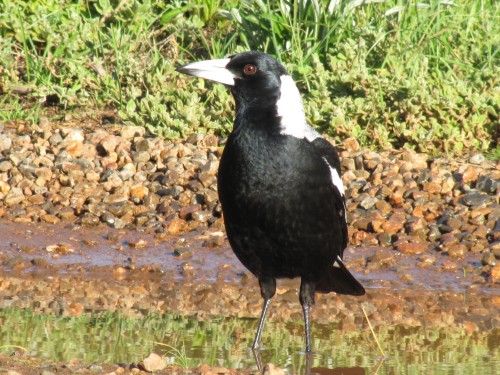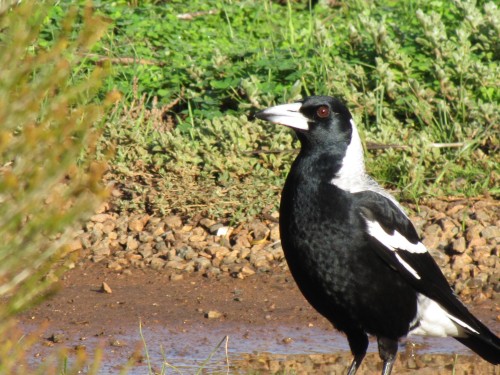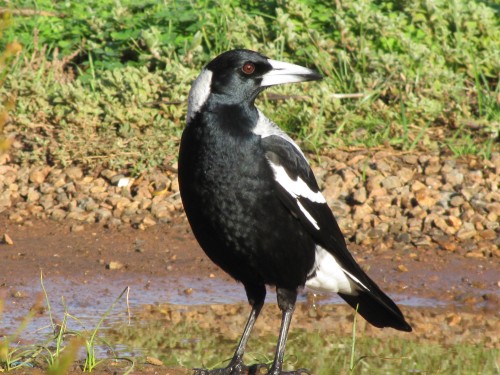Are the magpies getting ready to start nesting?
Australian Magpies are one of the most recognisable of Australian birds. They are common over large parts of Australia.
They are also highly territorial, and in the breeding season they can be very aggressive towards other magpies, other bird species, and, on occasions, towards humans. Their swoop – usually from behind and usually unexpected – can be quite terrifying to some people. They have been know to even draw blood if contact is made with vulnerable parts such as the head. Cyclists seem to attract swooping magpies far more than pedestrians, for some reason.
About this time of the year, however, they generally have not yet started nesting. Now is the time to reinforce their territorial claims, chasing one another in wild, noisy conflicts. I witnessed the start of this only a few days ago in our mallee scrub. Our five acre patch of scrub is the junction of three different magpie territories; the boundaries are fiercely defended. On the positive side, “our” resident magpies never swoop, for which we are thankful.
On my evening walk yesterday I heard the distinctive warning call of a male magpie, one whose territory is about a kilometre from our home. I looked up, and was interested to see a partially constructed nest in the tree over head. This particular bird is aggressive towards humans, so I’ll have to be careful walking along that part of the road in the coming weeks.
Opportunistic Magpies
It never ceases to amaze me when I consider how enterprising and opportunistic birds can be, especially when it comes to nesting time. It’s that time again and our resident Australian Magpies having been busy fighting to establish their territories. Our 5 acre block on the edge of town is the intersection of three territories, so at this time of the year there are many disputes over boundaries.
One pair dominates the area around our house and sheds and they are the birds that come most frequently to our bird baths and close to the house. They will often come right up to the front or back doors and allow us to get quite close. They are also quite happy to search for food only a metre or two from where we might be working or sitting in the garden. This includes our back veranda area where we often cook a BBQ and eat a meal.This is despite never having fed them in any way.
A few days ago my wife had a fleece of coloured wool out in the sunshine to dry. She was preparing it for spinning but our resident female magpie found it. Soon she was taking big chunks to the nest tree. Incensed at this free-loading, my wife brought the fleece onto the veranda and draped it over the clothes horse. Undeterred, the magpie enterprisingly found it and continued her nest lining activities. The photographic proof is shown on this post.
For those interested in learning more about magpies go to this article: The fearsome flute players. There is a special offer for readers of Trevor’s Birding.
Where are the cuckoos?
I’ve recently been busy updating my database of bird sightings. I must admit that while I have been doing my degree over the last three years that the database is sadly out of date. Still, I’m a bit more organised once again and making good progress on catching up on all those sightings.
One of the things that I suddenly realised while adding recent records to the database was the almost complete absence of cuckoos in our garden over the recent spring/summer seasons. Usually we hear them calling incessantly over many days, especially when host species like the honeyeaters are nesting.
The cuckoo species we usually get here here in Murray Bridge South Australia include:
- Horsfield’s Bronze-cuckoo
- Pallid Cuckoo (see photo above)
- Fan-tailed Cuckoo
- Shining-bronze Cuckoo (once only)
This year I’ve only heard the Horsfield’s Bronze-cuckoo, and then only a couple of times. Strange.
I don’t think I said or written anything to upset or offend them.
Will have to wait until later this year to see if they come back.
Good birding.
Magpie Larks nesting
Magpie Larks are a breeding resident bird in our garden. We see them every day, the strident calls filling the air on many occasions throughout the day. Although the call is sharp and loud it is melodious and not at all annoying – unless the bird is only metres away.
Throughout the day they flutter around from fence post to roof gutter to tree top. Then they soar down to ground level and search for some tasty snack on the ground.
Over the last two weeks the pair of Magpie Larks living around our house have been very busy gathering mud, grass and feathers to make a nest near our back veranda. The bowl shaped nest took quite a few days to construct.
Yesterday I saw the pair violently pursuing an Australian Magpie away from the nest, so I assumed they now have eggs to hatch. Sure enough, one of them was later seen sitting tight on the nest, only its tail protruding from the nest (see below – just the tail can been seen on the left hand side).
It has been quite a few years since they nested in our garden. In more recent times they have preferred the large gum trees in our neighbour’s garden.
White-winged Choughs feeding young
Over recent weeks the flock of White-winged Choughs that frequently visit our garden have been largely absent. A few days ago I found out why.
They’ve been nesting somewhere nearby – but far away enough not to attract my attention. Now every time they pass through looking for a feed (and disturbing the Australian Magpies into the bargain) they have several young ones to feed, their begging calls making sure they aren’t forgotten.











